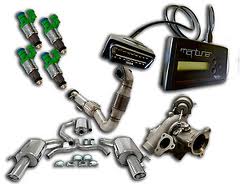Turbo upgrades:
Adding an increased capacity turbo or fitting forced induction to your NASP (Naturally Aspirated) engine will provide the largest gains in power. However, fitting a NASP engine with a turbo is a major feat of engineering and can be costly. Twincharging (adding a turbo and supercharger) is becoming a very popular modification.
Aspirated) engine will provide the largest gains in power. However, fitting a NASP engine with a turbo is a major feat of engineering and can be costly. Twincharging (adding a turbo and supercharger) is becoming a very popular modification.
Upgrading your existing turbo is a much more straightforward task as a direct replacement can simply be bolted on.
Chip tuning and remaps:
Altering the timing settings of the engine and/or altering the boost and fuelling brings large gains in power. With turbo engines it is possible to see gains of 30-40% in power without affecting the car`s reliability. However, with NASP engines, power gains are typically only around 10%.
Fast road cams:
Fitting an improved camshaft can dramatically alter the exhaust and intake durations and can significantly increase engine power. However, there is a downside in that a new camshaft can push the engine`s power right up into the higher end of its RPM band. It is vital that you choose the right cam.
Exhaust and intake upgrades:
Improving airflow through the engine typically results in more power. The larger your engine and the larger its RPM range, the greater the increase in power will be.
Larger engines and those with a turbo tend to respond best to performance exhausts, performance air filters and induction kits.
Valve seat angles, polishing and porting:
Getting air into your engine more efficiently and reducing turbulence levels generally allows your engine to burn increased amounts of fuel. This results in power gains. DIY grinding, polishing and porting will rarely result in any gains and is best performed by a qualified expert with all the right equipment.
Fuel upgrades:
Performance fuel pumps and larger injectors are usually effective mods, especially if following previous modifications fuel starvation has now become an issue.
Increased levels of fuel means that more air is needed to maintain the fuel to oxygen ratio so this really does need to be done properly.
Major engine upgrades:
This would include a crank polish and grind, reboring, balancing and cryo treating.
Because this requires a full strip down followed by an engine rebuild this is not a modification for the faint hearted.
Handling Modifications:
Upgrading your suspension and having it correctly aligned/adjusted will totally transform your car`s handling. Lowering the centre of gravity improves cornering but going too low restricts the travel of the suspension and this can cause the wheel to slide over the road surface rather than gripping it.
Brake Upgrades:
Larger brake discs dissipate the heat that is generated under braking better than small discs and will stop a car sooner and also last longer. A cheaper alternative to a whole-brake upgrade is to fit some high-friction brake pads or to replace your existing ones with grooved and/or vented ones.
Transmission modifications:
The power generated by an engine reaches the wheels only after passing through the car`s transmission. Losses in power can occur via the clutch and within standard gearboxes which are designed for fuel economy and low noise levels rather than for optimum performance.
Choosing different ratios may improve acceleration and opting for a dog box will help to avoid transmission losses but will result in more noise and a notchy gear box.
Before making any modifications it is best to get some expert advice from a company such as torquecars.com.
